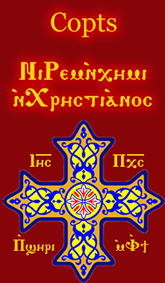Related Research Articles

There have been many Coptic versions of the Bible, including some of the earliest translations into any language. Several different versions were made in the ancient world, with different editions of the Old and New Testament in five of the dialects of Coptic: Bohairic (northern), Fayyumic, Sahidic (southern), Akhmimic and Mesokemic (middle). Biblical books were translated from the Alexandrian Greek version.

Uncial 070, ε 6 (Soden), is a Greek-Coptic diglot uncial manuscript of the New Testament. Palaeographically it has been assigned to the 6th century.
Minuscule 75, ε 176, known as Codex Genevensis, is a Greek minuscule manuscript of the New Testament, on parchment leaves. Palaeographically it has been assigned to the 11th century. The codex has complex contents. It was adapted for liturgical use. It has complex contents, and full marginalia.

A Plain Introduction to the Criticism of the New Testament: For the Use of Biblical Students is one of the books of Frederick Henry Ambrose Scrivener (1813–1891), biblical scholar and textual critic. In this book Scrivener listed over 3,000 Greek manuscripts of the New Testament, as well as manuscripts of early versions. It was used by Gregory for further work.
Codex Bodmer III, is a Coptic uncial manuscript of the fourth Gospel, and the first four chapters of Genesis, dated palaeographically to the 4th century. It contains the text of the Gospel of John with some lacunae. It is written in an early Bohairic dialect of Coptic language.
Huntington 17, bilingual Bohairic-Arabic, uncial manuscript of the New Testament, on a paper. It is dated by a colophon to the year 1174. It is the oldest manuscript with complete text of the four Gospels in Bohairic.
Huntington 20, is a Bohairic-Greek, uncial manuscript of the New Testament, on paper. Palaeographically it has been assigned to the 13th century.
Codex Marshall Or. 5, is a Bohairic-Greek, uncial manuscript of the New Testament, on a paper. Palaeographically it has been assigned to the 14th century.
Codex Marshall Or. 6, is a Bohairic-Greek, uncial manuscript of the New Testament, on a paper. It is dated by the Colophon to the year 1320.
Minuscule 599 (in the Gregory-Aland numbering), A599 (von Soden), is a Greek minuscule manuscript of the New Testament, on paper. Palaeographically it has been assigned to the 15th century. The manuscript has complex contents. It was labelled by Scrivener as 467. It has marginalia.
Minuscule 668, ε 1205, is a Greek minuscule manuscript of the New Testament, on parchment. Palaeographically it has been assigned to the 13th or 14th century. The manuscript has complex contents. Scrivener labelled it by 1144e.
Codex Marshall Or. 6, is a Bohairic, uncial manuscript of the New Testament, on a paper. Palaeographically it has been assigned to the 16th century.
George William Horner (1849–1930) was a British biblical scholar, an editor of the text of the New Testament in the dialects of the Coptic language.

Codex Oriental Ms. 424, designated by siglum A1 (Horner), t (de Lagarde [= Boetticher]), is written in two languages Bohairic-Arabic, uncial manuscript of the New Testament, on paper. It is dated by a colophon to the year 1308. Many leaves of the codex were lost.
Oriental MS 425, is a bilinguical Bohairic-Arabic, uncial manuscript of the New Testament, on paper, now in the British Library in London. It is dated by a colophon to the year 1308. The manuscript is lacunose.
Oriental MS 426, bilinguical Bohairic-Arabic, uncial manuscript of the New Testament, on paper, now in the British Library in London. It is dated to the 13th century. The manuscript is lacunose.
Add MS 5995, bilingual Bohairic-Arabic, uncial manuscript of the New Testament, on paper. It is dated to the fourteenth century. The manuscript has complex contents.
Oriental MS 1001, Bohairic-Arabic, uncial manuscript of the New Testament, on paper. It is dated to the year 1663. Horner designated the manuscript by siglum H3.
Codex Copticus Tischendorfianus I is a Coptic uncial manuscript of the four Gospels, dated palaeographically to the 10th or 11th century. Originally it contained the text of the four Gospels. It is written in Sahidic dialect of Coptic language. It is classified on the list of Coptic manuscripts of the New Testament on the position sa 181. The manuscript has survived in a fragmentary condition.
References
- 1 2 3 George Horner, The Coptic Version of the New Testament in the Northern Dialect, otherwise called Memphitic and Bohairic, 1 vol. (1898), p. LXXXIV
- 1 2 3 4 Scrivener, Frederick Henry Ambrose; Edward Miller (1894). A Plain Introduction to the Criticism of the New Testament . 1. London: George Bell & Sons. pp. 112–113.
- 1 2 Gregory, Caspar René (1902). Textkritik des Neuen Testaments. 2. Leipzig. p. 539.
- ↑ George Horner, The Coptic Version of the New Testament in the Northern Dialect, otherwise called Memphitic and Bohairic, 1 vol. (1898), pp. LXXXII-LXXXIII
- ↑ Constantin von Tischendorf, Editio Octava Critica Maior , vol. III, p. 870
- ↑ George Horner, The Coptic Version of the New Testament in the Northern Dialect, otherwise called Memphitic and Bohairic, 1 vol. (1898), pp. LXXXI-LXXXIV